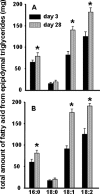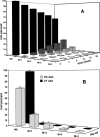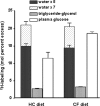Triglyceride synthesis in epididymal adipose tissue: contribution of glucose and non-glucose carbon sources
- PMID: 19114707
- PMCID: PMC2649080
- DOI: 10.1074/jbc.M808668200
Triglyceride synthesis in epididymal adipose tissue: contribution of glucose and non-glucose carbon sources
Abstract
The obesity epidemic has generated interest in determining the contribution of various pathways to triglyceride synthesis, including an elucidation of the origin of triglyceride fatty acids and triglyceride glycerol. We hypothesized that a dietary intervention would demonstrate the importance of using glucose versus non-glucose carbon sources to synthesize triglycerides in white adipose tissue. C57BL/6J mice were fed either a low fat, high carbohydrate (HC) diet or a high fat, carbohydrate-free (CF) diet and maintained on 2H2O (to determine total triglyceride dynamics) or infused with [6,6-(2)H]glucose (to quantify the contribution of glucose to triglyceride glycerol). The 2H2O labeling data demonstrate that although de novo lipogenesis contributed approximately 80% versus approximately 5% to the pool of triglyceride palmitate in HC- versus CF-fed mice, the epididymal adipose tissue synthesized approximately 1.5-fold more triglyceride in CF- versus HC-fed mice, i.e. 37+/-5 versus 25+/-3 micromolxday(-1). The [6,6-(2)H]glucose labeling data demonstrate that approximately 69 and approximately 28% of triglyceride glycerol is synthesized from glucose in HC- versus CF-fed mice, respectively. Although these data are consistent with the notion that non-glucose carbon sources (e.g. glyceroneogenesis) can make substantial contributions to the synthesis of triglyceride glycerol (i.e. the absolute synthesis of triglyceride glycerol from non-glucose substrates increased from approximately 8 to approximately 26 micromolxday(-1) in HC- versus CF-fed mice), these observations suggest (i) the importance of nutritional status in affecting flux rates and (ii) the operation of a glycerol-glucose cycle.
Figures





References
-
- Behn, A., and Ur, E. (2006) Curr. Opin. Cardiol. 21 353–360 - PubMed
-
- Bray, G. A., and Bellanger, T. (2006) Endocrine 29 109–117 - PubMed
-
- Daniels, S. R. (2006) Future Child 16 47–67 - PubMed
-
- Dietz, W. H. (2004) N. Engl. J. Med. 350 855–857 - PubMed
-
- Bederman, I. R., Dufner, D. A., Alexander, J. C., and Previs, S. F. (2006) Am. J. Physiol. 290 E1048–E1056 - PubMed
Publication types
MeSH terms
Substances
Grants and funding
LinkOut - more resources
Full Text Sources

